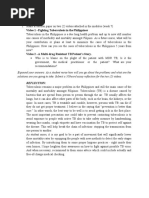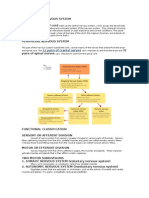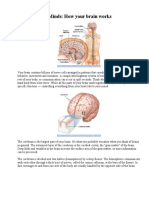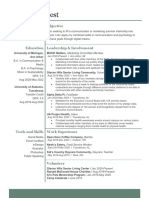The Human Brain: Different Types of Glial
The Human Brain: Different Types of Glial
Uploaded by
HelenJaccontiCopyright:
Available Formats
The Human Brain: Different Types of Glial
The Human Brain: Different Types of Glial
Uploaded by
HelenJaccontiOriginal Title
Copyright
Available Formats
Share this document
Did you find this document useful?
Is this content inappropriate?
Copyright:
Available Formats
The Human Brain: Different Types of Glial
The Human Brain: Different Types of Glial
Uploaded by
HelenJaccontiCopyright:
Available Formats
The human brain
Weighing in at three pounds, on average, this spongy mass of
fat and protein is made up of two overarching types of cells—
called glia and neurons—and it contains many billions of each.
Neurons are notable for their branch-like projections called
axons and dendrites, which gather and transmit
electrochemical signals. Different types of glial cells provide
physical protection to neurons and help keep them, and the
brain, healthy
The Anatomy of the brain
The cerebrum is the largest part of the brain, accounting for 85
percent of the organ's weight. The distinctive, deeply wrinkled
outer surface is the cerebral cortex.
The cerebrum has two halves, or hemispheres, that are further
divided into four regions, or lobes. The frontal lobes, located
behind the forehead, are involved with speech, thought,
learning, emotion, and movement. Behind them are the parietal
lobes, which process sensory information such as touch,
temperature, and pain. At the rear of the brain are the occipital
lobes, dealing with vision. Lastly, there are the temporal lobes,
near the temples, which are involved with hearing and memory.
The second-largest part of the brain is the cerebellum, which
sits beneath the back of the cerebrum. It plays an important
role in coordinating movement, posture, and balance.
The third-largest part is the diencephalon, located in the core of
the brain. A complex of structures roughly the size of an
apricot, its two major sections are the thalamus and
hypothalamus. The thalamus acts as a relay station for
incoming nerve impulses from around the body that are then
forwarded to the appropriate brain region for processing. The
hypothalamus controls hormone secretions from the nearby
pituitary gland. These hormones govern growth and instinctual
behaviors, such as when a new mother starts to lactate. The
hypothalamus is also important for keeping bodily processes
like temperature, hunger, and thirst balanced.
Seated at the organ's base, the brain stem controls reflexes and
basic life functions such as heart rate, breathing, and blood
pressure. It also regulates when you feel sleepy or awake and
connects the cerebrum and cerebellum to the spinal cord.
Your brain has an amazing barrier which is semi-permable that
prevents toxins, pathogens, and other harmeful substances.
While at the same time allowing nutrients and oxygen to pass
through. This barrier is made up of special tightly bound cells.
This barrier is clled the blood-brain barrier.
The structures within the brain are made up of about 100 billion neurons, as well as
trillions of support cells called glia. Neurons may be the more important cells in the
brain that relay messages about what you're thinking, feeling, or doing. But they
couldn't do it without a little help from their friends, the glial cells.
There are a few different types of glia in the brain: oligodendrocytes,
microglia, and astrocytes. Each is needed to optimize brain function.
Oligodendrocytes are specialized cells that wrap tightly around axons to form
the myelin sheath. These cells speed up the electrical signals (action
potentials) that travel down an axon. Without oligodendrocytes, an action
potential would travel down an axon 30 times slower!
Microglia are special immune cells found only in the brain that can detect
damaged or unhealthy neurons. They eat foreign invaders (bacteria and
viruses), then display the chewed up parts on their cell surface to signal for
help.
https://www.innerbody.com/image/nerv02.html this is
a link for a page with an article about the brain it is very
scientific.
https://www.healthline.com/human-body-
maps/brain#anatomy-and-function another link for a
page about the brain also very scientific.
You might also like
- Living WildFit EbookDocument14 pagesLiving WildFit EbookSarthak Grover100% (2)
- 2 Self Reflection SWRBDocument3 pages2 Self Reflection SWRBapi-25834347557% (7)
- Video 1 - Fighting Tuberculosis in The PhilippinesDocument2 pagesVideo 1 - Fighting Tuberculosis in The Philippineskuu faal0% (1)
- Brain: Learn More About The Most Complex Organ in The Human BodyDocument5 pagesBrain: Learn More About The Most Complex Organ in The Human BodyBryan Erazo Menendez Macias100% (1)
- Physiological Psychology ReviewerDocument13 pagesPhysiological Psychology ReviewerLeopando Rod CyrenzNo ratings yet
- Anatomy and PhysiologyDocument5 pagesAnatomy and Physiologyssairej06No ratings yet
- Brain CellsDocument4 pagesBrain CellsJulius RicardeNo ratings yet
- โท the BrainDocument39 pagesโท the BrainFadil Wanna-mart100% (1)
- Human BrainDocument12 pagesHuman BrainJashwanthNo ratings yet
- Nervou S System:: NeuronsDocument16 pagesNervou S System:: NeuronsFizzah100% (4)
- ANAPHYDocument34 pagesANAPHYalenabotrishaann792No ratings yet
- Nervous SystemDocument3 pagesNervous SystemshhhNo ratings yet
- Grade 12 NotesDocument5 pagesGrade 12 Noteshafsag307No ratings yet
- Human BrainDocument11 pagesHuman Brainmuskaan.kukrejaNo ratings yet
- Structure and Function of The Central Nervous SystemDocument10 pagesStructure and Function of The Central Nervous Systemzahidkulfa68No ratings yet
- Nervous SystemDocument34 pagesNervous SystemumeazabashaNo ratings yet
- Anatomy of The Brain - GeeksforGeeksDocument11 pagesAnatomy of The Brain - GeeksforGeeksopheokani2000No ratings yet
- Cognitive Development ModuleDocument20 pagesCognitive Development ModuleMaria Mendoza AlejandriaNo ratings yet
- Vander WaltDocument12 pagesVander Walt2022159996No ratings yet
- Anatomy of The Brain: Brain DivisionsDocument3 pagesAnatomy of The Brain: Brain DivisionsUsagi TsukinoNo ratings yet
- Anatomy and PhysiologyDocument8 pagesAnatomy and Physiologymhel03_chickmagnetNo ratings yet
- Ms - Angeline M.SC (N) Previous Year Psychiatric Nursing Choithram College of NursingDocument79 pagesMs - Angeline M.SC (N) Previous Year Psychiatric Nursing Choithram College of NursingPankaj TirkeyNo ratings yet
- OUR BODY Chapter - I (Science Class IV)Document4 pagesOUR BODY Chapter - I (Science Class IV)doultaniskNo ratings yet
- Raheem Fatima AssignmentDocument15 pagesRaheem Fatima Assignmentzarabatooltahir123No ratings yet
- The Central Nervous SystemDocument7 pagesThe Central Nervous Systemjoeywap29No ratings yet
- Anatomy and Physiology of The BrainDocument22 pagesAnatomy and Physiology of The BrainJonathan Delos ReyesNo ratings yet
- Neurosciencie For KidsDocument10 pagesNeurosciencie For KidsAna Maria RodriguezNo ratings yet
- Anatomy and Physiology Chapter 19 Neurological SystemDocument38 pagesAnatomy and Physiology Chapter 19 Neurological SystemBrantNo ratings yet
- BRAIN , Contents, And Surroundings _241110_174836Document61 pagesBRAIN , Contents, And Surroundings _241110_174836osaretinexcellent71No ratings yet
- Nervous SystemDocument46 pagesNervous SystemMac Gab100% (3)
- The Human BrainDocument6 pagesThe Human BraindamanzurNo ratings yet
- Raheem Fatima Assignment 1Document26 pagesRaheem Fatima Assignment 1zarabatooltahir123No ratings yet
- Assignment 1Document24 pagesAssignment 1zarabatooltahir123No ratings yet
- How Your Brain WorksDocument12 pagesHow Your Brain WorksPallavi BhartiNo ratings yet
- Assignment: TOPIC: Human BrainDocument4 pagesAssignment: TOPIC: Human BrainMaham AzmatNo ratings yet
- Brain and StructuteDocument10 pagesBrain and Structutedhatreyi.g.gubbalaNo ratings yet
- Preparation in Psychology: Bicol University College of Engineering East Campus LegazpiDocument8 pagesPreparation in Psychology: Bicol University College of Engineering East Campus LegazpiKielNo ratings yet
- Anatomy and PhysiologyDocument11 pagesAnatomy and PhysiologyremegelbristolNo ratings yet
- Human Growth And DevelopmentDocument74 pagesHuman Growth And Developmentanjanasaju1213No ratings yet
- c5730d07 Week 3 ss3Document4 pagesc5730d07 Week 3 ss3isabellaamelia54321No ratings yet
- Module 2: Physiological Basis of BehaviorDocument23 pagesModule 2: Physiological Basis of BehaviorRoxie May Theresse AbagatnanNo ratings yet
- COGNITIVE-NEUROSCIENCEDocument4 pagesCOGNITIVE-NEUROSCIENCEAbigail Joy AnchetaNo ratings yet
- General Biology II Crib Sheet (Mtes)Document3 pagesGeneral Biology II Crib Sheet (Mtes)JerseyNo ratings yet
- "Cognitive Psychology": Sir Faisal Mumtaz Zeeshan Akhtar Bsap 3 005 20 Jan, 2021Document9 pages"Cognitive Psychology": Sir Faisal Mumtaz Zeeshan Akhtar Bsap 3 005 20 Jan, 2021Zeeshan AkhtarNo ratings yet
- Kepy 01 08 33 EtextDocument13 pagesKepy 01 08 33 Etextmradul guptaNo ratings yet
- Unit-03 - Biological Basis of BehaviourDocument58 pagesUnit-03 - Biological Basis of BehaviourT-rexNo ratings yet
- Biological Bases of BehaviorDocument74 pagesBiological Bases of BehaviorKylie AnneNo ratings yet
- Anatomia e Sistema NerosoDocument8 pagesAnatomia e Sistema NerosoChloe BujuoirNo ratings yet
- brain-pp-5Document38 pagesbrain-pp-5justinbawa192No ratings yet
- The Central Nervous SystemDocument24 pagesThe Central Nervous SystemBlanche Mascarinas LaborteNo ratings yet
- Nervous SystemDocument26 pagesNervous SystemNABIHA NAEEMNo ratings yet
- Assignment NAME: Sana SohailDocument8 pagesAssignment NAME: Sana SohailMuiz SaddozaiNo ratings yet
- Assignment NAME: Sana SohailDocument8 pagesAssignment NAME: Sana SohailMuiz SaddozaiNo ratings yet
- ZARISH JAVED053, COGNITIVE, BSCP4ADocument8 pagesZARISH JAVED053, COGNITIVE, BSCP4Ajaverianoor030No ratings yet
- The Brain and Nervous System (Psychology) Unit 14: An Academic ReportDocument7 pagesThe Brain and Nervous System (Psychology) Unit 14: An Academic ReportOlatokunbo SinaayomiNo ratings yet
- Brain Summary Part 2Document26 pagesBrain Summary Part 2Ayesha ahmedNo ratings yet
- Parts of BrainDocument5 pagesParts of BrainyousifpmnNo ratings yet
- Master Your Mind: Neuroscience Secrets to Unlocking Your PotentialFrom EverandMaster Your Mind: Neuroscience Secrets to Unlocking Your PotentialNo ratings yet
- The Secret Life of the Brain: Exploring the Mysteries and Wonders of Our Most Vital OrganFrom EverandThe Secret Life of the Brain: Exploring the Mysteries and Wonders of Our Most Vital OrganNo ratings yet
- Chocolate, Quinoa & Pecan Mud Cake: This Cake Is Easy and YummyDocument1 pageChocolate, Quinoa & Pecan Mud Cake: This Cake Is Easy and YummyHelenJaccontiNo ratings yet
- Abbreviations: Stitch (Es) TR - Treble Beg - Beginning DC - Double CrochetDocument2 pagesAbbreviations: Stitch (Es) TR - Treble Beg - Beginning DC - Double CrochetHelenJaccontiNo ratings yet
- Avocado Oil Chocolate CakeDocument1 pageAvocado Oil Chocolate CakeHelenJaccontiNo ratings yet
- Ponch Shawl EdelweissDocument1 pagePonch Shawl EdelweissHelenJaccontiNo ratings yet
- 100 Classical Authors: Jane AustenDocument2 pages100 Classical Authors: Jane AustenHelenJaccontiNo ratings yet
- Lemon Poppy Seed CakeDocument1 pageLemon Poppy Seed CakeHelenJaccontiNo ratings yet
- So Let's Get Started: TermsDocument1 pageSo Let's Get Started: TermsHelenJaccontiNo ratings yet
- Apple Cake: by Teresa Cutter This Delicious Moist Cake Is One You Will Make Again and AgainDocument1 pageApple Cake: by Teresa Cutter This Delicious Moist Cake Is One You Will Make Again and AgainHelenJaccontiNo ratings yet
- Eco Friendly Shopping BagDocument2 pagesEco Friendly Shopping BagHelenJaccontiNo ratings yet
- The Book ListDocument10 pagesThe Book ListHelenJaccontiNo ratings yet
- 9000 - Case Report PDFDocument4 pages9000 - Case Report PDFResa Yudhisti100% (1)
- YASKAWA NX100 Concurrent IO Manual PDFDocument341 pagesYASKAWA NX100 Concurrent IO Manual PDFRafaelNo ratings yet
- Child Psychology Psychiatry - 2006 - Goodman - The Strengths and Difficulties Questionnaire A Research NoteDocument7 pagesChild Psychology Psychiatry - 2006 - Goodman - The Strengths and Difficulties Questionnaire A Research NoteSonia NgNo ratings yet
- Medical Imaging To CT Scan QuizletDocument2 pagesMedical Imaging To CT Scan QuizletMika GrantozaNo ratings yet
- CHN Unit I Historical BackgroundDocument29 pagesCHN Unit I Historical BackgroundKAYE ANN A. ABENESNo ratings yet
- Phil IRI Answer SheetDocument4 pagesPhil IRI Answer SheetEmelie IsitoNo ratings yet
- Case Summary NewDocument24 pagesCase Summary NewIqra AlizehNo ratings yet
- 2 - Artigo de CefalometriaDocument7 pages2 - Artigo de CefalometriaSérgio Éberson da Silva MaiaNo ratings yet
- General Order: 4 Edition 2012Document56 pagesGeneral Order: 4 Edition 2012Fiftys Sabz KedewaNo ratings yet
- Product European SheetDocument2 pagesProduct European SheetLast CubeNo ratings yet
- 62d81b1dbb3b925e4e80ff3c - 10 Hiring Tips To Help You Scale Your Team From 6 To 60Document12 pages62d81b1dbb3b925e4e80ff3c - 10 Hiring Tips To Help You Scale Your Team From 6 To 60Yatharth SahooNo ratings yet
- Every Roses Has It's ThornsDocument2 pagesEvery Roses Has It's ThornsKimberly Asuncion DalagNo ratings yet
- CGHS Chennai Empanelled Hospital List As On Apr 23Document7 pagesCGHS Chennai Empanelled Hospital List As On Apr 23Banumathy RajappaNo ratings yet
- EMA Good Pharmacovigilance Practices - European Medicines AgencyDocument27 pagesEMA Good Pharmacovigilance Practices - European Medicines AgencyJorges SpNo ratings yet
- Taylor Brest ResumeDocument1 pageTaylor Brest Resumeapi-548184095No ratings yet
- BSBXCM501 Slideshow - v1.0 - June 2022Document99 pagesBSBXCM501 Slideshow - v1.0 - June 2022jiemeranoNo ratings yet
- Public Administration Dissertation AwardDocument8 pagesPublic Administration Dissertation AwardHelpWithWritingAPaperForCollegeFargo100% (1)
- 5 6321010889734489333Document4 pages5 6321010889734489333Ruhaifi EpiNo ratings yet
- Pulse Test DiagnosisDocument19 pagesPulse Test DiagnosisJavierNo ratings yet
- Product CatalogDocument105 pagesProduct CatalogsyitaNo ratings yet
- Ghotbi 2020Document13 pagesGhotbi 2020valeria diazNo ratings yet
- Thesis Scope of Study SampleDocument5 pagesThesis Scope of Study Samplegbv8rcfq100% (2)
- Title: Take Table Reservation: Performance Task For Module No.1 (Week1)Document2 pagesTitle: Take Table Reservation: Performance Task For Module No.1 (Week1)Jellane Seletaria100% (1)
- Walk in Interview - TO-IIDocument2 pagesWalk in Interview - TO-IIRohit ChauhanNo ratings yet
- Action taken-Dechallenge-Rechallenge-Causality.pptxDocument19 pagesAction taken-Dechallenge-Rechallenge-Causality.pptxajjshhs512No ratings yet
- 10 Ways To Stop OverthinkingDocument2 pages10 Ways To Stop OverthinkingMarcos OliveiraNo ratings yet
- Fispq Dieselpower BiocontrolDocument15 pagesFispq Dieselpower Biocontrolalbamar69No ratings yet



































































































